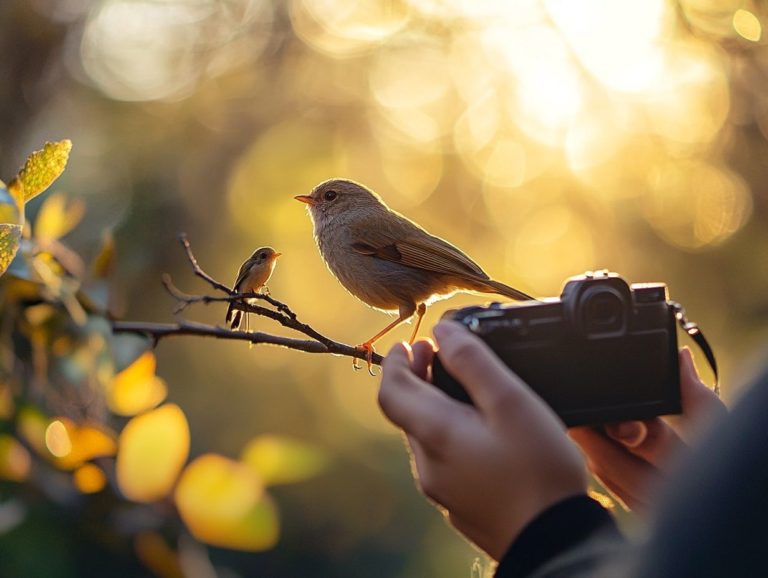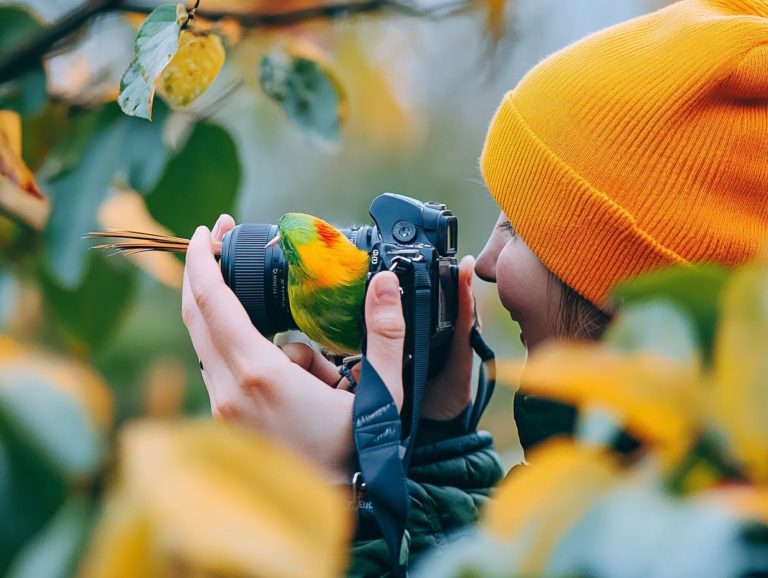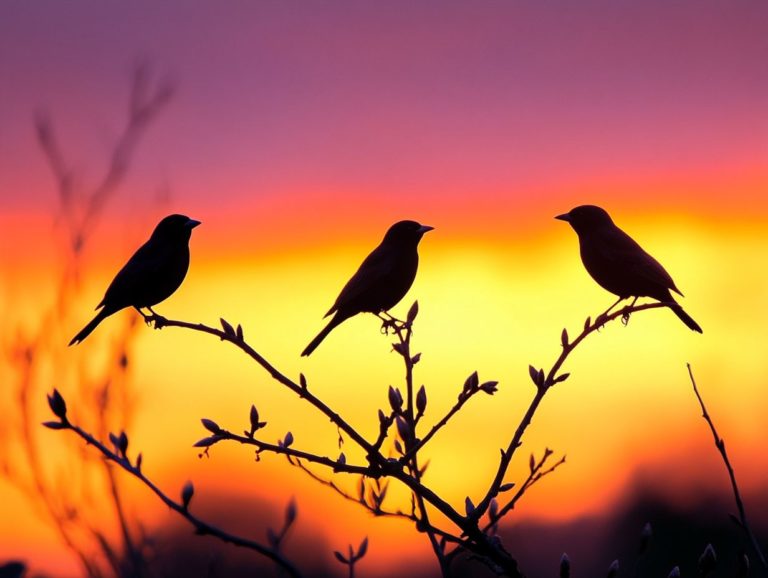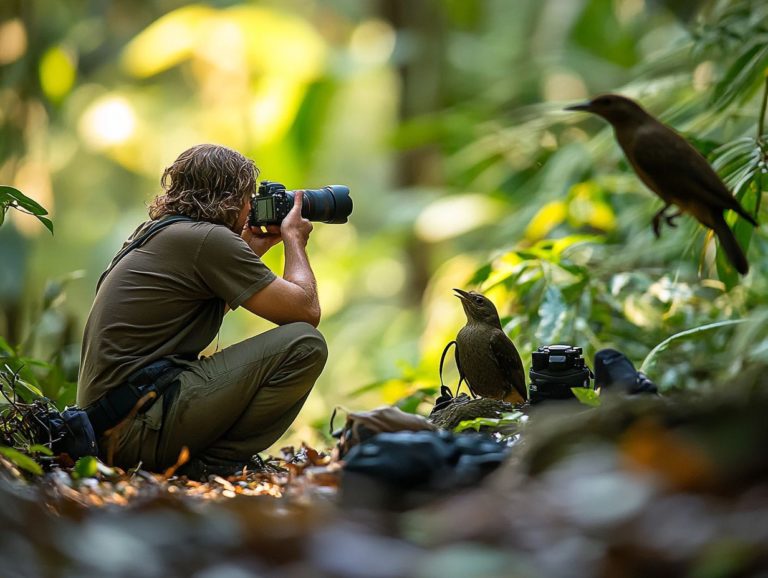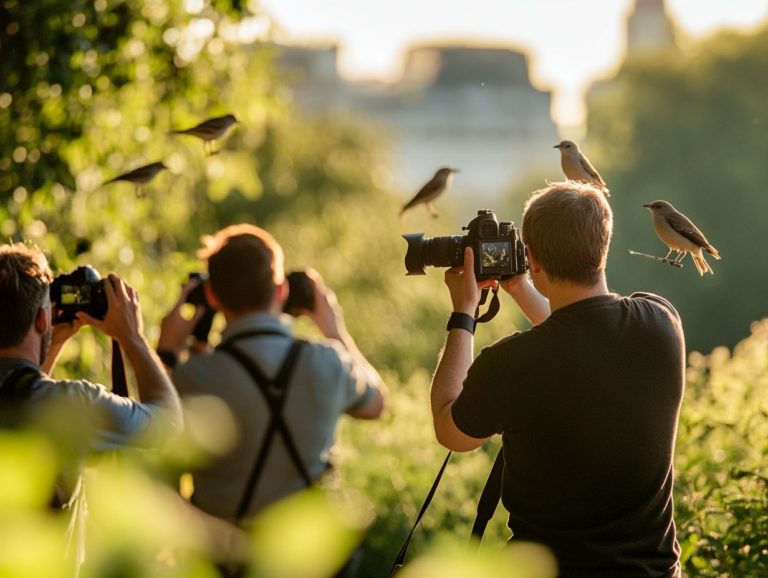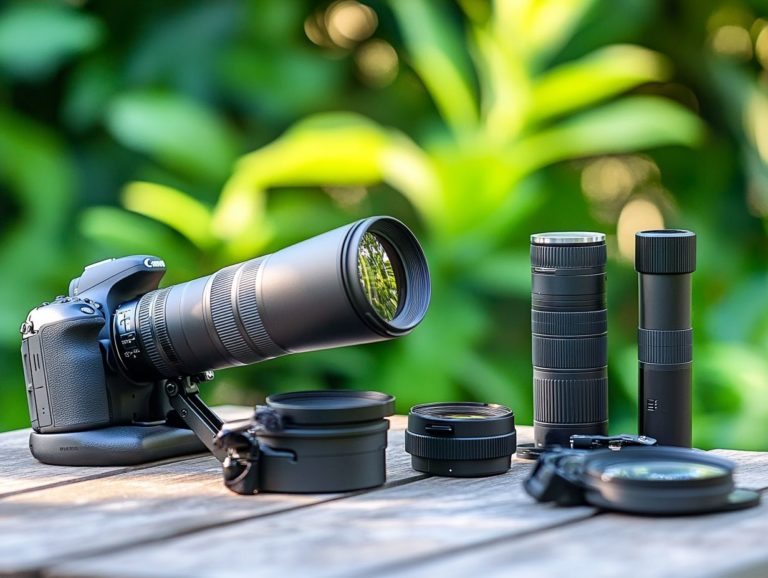Best Practices for Bird Photography Composition
Bird photography is a captivating art that demands your keen eye and a solid grasp of composition.
Essential techniques like the Rule of Thirds and the use of leading lines will help you create visually striking shots every time. Having the right gear and camera settings is vital for enhancing your results. Also, steer clear of common pitfalls like blurred images or subpar lighting.
With insights on leveraging unique perspectives and various angles of view, you ll be well-equipped to capture breathtaking avian moments.
Dive in and elevate your bird photography skills today! Capture stunning moments that will leave your audience in awe!
Contents
- Key Takeaways:
- Understanding the Basics
- Composition Techniques for Capturing Birds
- Equipment and Settings for Bird Photography
- Common Mistakes to Avoid
- Tips for Capturing Unique and Creative Shots
- Frequently Asked Questions
- What are the best practices for bird photography composition?
- Why is understanding bird behavior important for composition?
- How does the rule of thirds apply to bird photography composition?
- Why is lighting important in bird photography composition?
- How can background affect bird photography composition?
- What are some unique angles to consider for bird photography composition?
Key Takeaways:
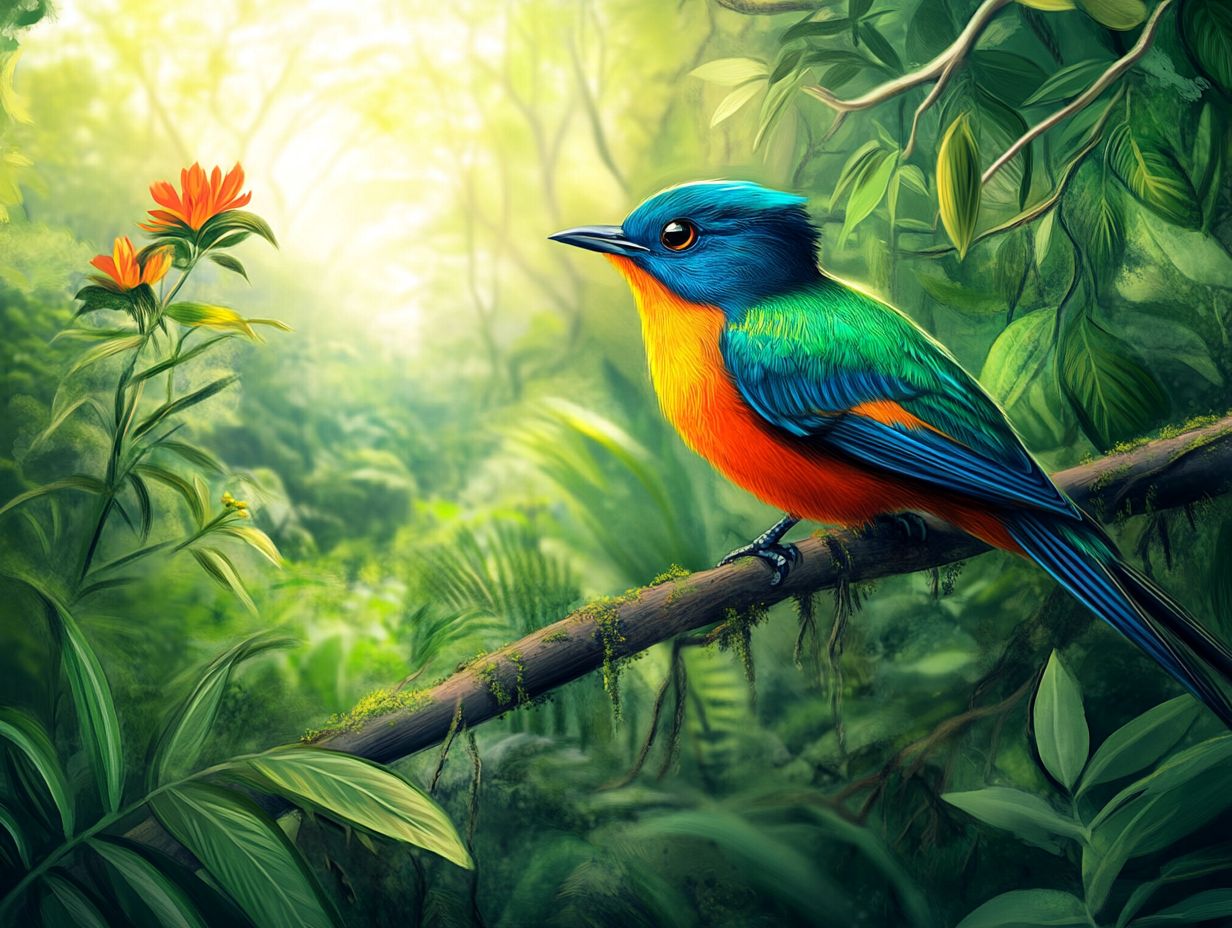
- Always consider the basics of composition, such as the rule of thirds, leading lines, and foreground/background elements, when photographing birds in different environments.
- Choose the right equipment and camera settings to achieve optimal composition in your bird photography.
- Avoid common mistakes like blurry images, cluttered backgrounds, and poor lighting to create stunning bird photos.
- Get creative and experiment with props, natural elements, and different perspectives to capture unique and captivating shots of birds.
Understanding the Basics
Grasping the fundamentals of bird photography is crucial for any aspiring photographer, particularly if you’re just starting out. This involves understanding key concepts like image composition and fieldwork techniques, as well as applying tips for photographing rare bird species that can significantly boost your chances of capturing breathtaking bird images.
By immersing yourself in these foundational elements, you can elevate your skills and craft visually stunning pictures that resonate with viewers, beautifully showcasing the elegance and behavior of birds in their natural environments.
Composition Techniques for Capturing Birds
Composition techniques play an essential role in bird photography. They guide you in showcasing your subjects effectively while adhering to the principles of image composition, as detailed in how to use composition to enhance bird photos.
By using strategies like the rule of thirds, thoughtful subject placement, and the strategic use of negative space, you can craft striking images that truly captivate your audience.
Additionally, understand visual lines to enhance your shots and seize every photographic opportunity with dynamism and flair, maximizing your fieldwork experiences.
Rule of Thirds
The rule of thirds is a cornerstone of composition that can elevate the visual allure of your bird photographs. Subdivide the frame into a 3×3 grid and place your subject along these lines or at their intersections. For those looking to enhance their skills further, adhering to best practices for bird photography ethics creates dynamic simplicity that captivates your audience.
This technique serves as a valuable guide for framing your shots. It encourages compositions that exude balance and intention. When capturing close-up portraits of a bird, positioning the subject’s eye along one of the horizontal lines draws the viewer in, fostering a deeper connection. For those specifically interested in avian photography, exploring the best practices for capturing birds in flight can enhance your skills even further.
In landscape-format shots, such as a majestic eagle soaring against a dramatic sky, aligning the horizon with the upper or lower third of the frame amplifies the sense of space and movement, crafting a more compelling narrative within the image.
By effectively applying the rule of thirds, you can transform ordinary bird photography into a captivating visual story.
Leading Lines
Leading lines are an invaluable tool in your photography arsenal. They skillfully guide the viewer’s eye towards your main subject, infusing your images of birds with depth and intrigue. By thoughtfully positioning these visual lines within your frame, you can elevate subject placement and craft a composition that captivates.
You ll find these lines naturally occurring in your surroundings think of the gentle curve of a riverbank, a meandering path, or even branches that artfully direct the gaze toward your avian focal point. To maximize their impact, consider your angle of view; shooting from a lower perspective can enhance those leading lines while fostering a more intimate connection with the bird.
Experimenting with depth of field allows those background lines to seamlessly integrate into your scene, ensuring that the bird remains the star of the show, free from distractions.
Foreground and Background
The interplay between foreground and background is crucial in bird photography, shaping how you perceive the main subject. By thoughtfully considering background elements and utilizing negative space, which refers to the area around your subject that helps it stand out, you can craft images that are not only visually stunning but also accentuate the bird’s presence through effective depth of field.
In this arena, how you manage elements like foliage or water can either elevate or undermine your composition. For example, employing a shallow depth of field, which blurs the background, makes the bird stand out in sharp focus. Incorporating natural frames, such as branches, helps guide the viewer s eye toward the subject, adding depth to the overall scene.
It s vital to scout locations beforehand, surveying potential perches and backgrounds. This preparation ensures that each shot captures the beauty and behavior of your avian subject, free from competing distractions.
Angles and Perspectives
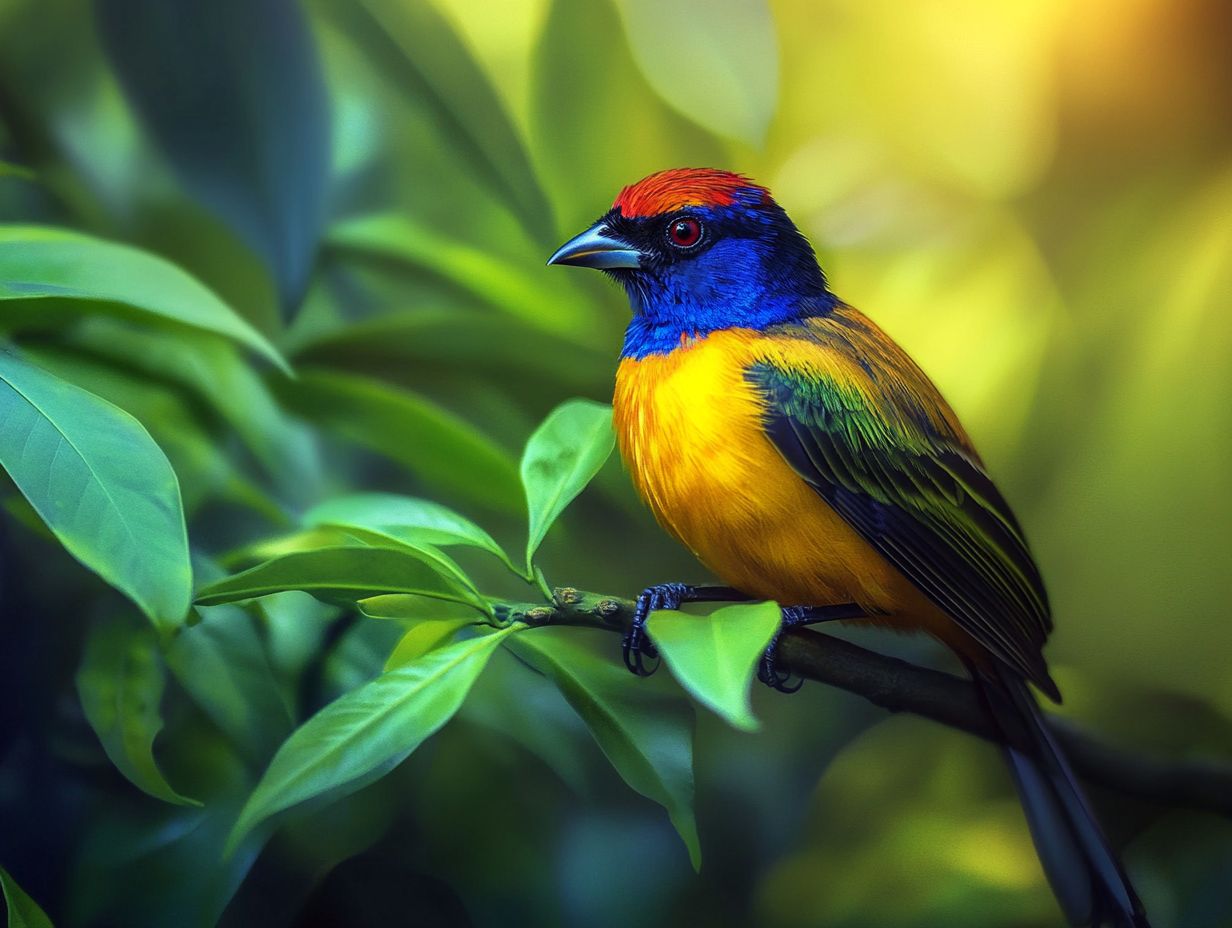
The angle of view can dramatically shift your perception of a bird photograph. It is essential for you to experiment with different perspectives to capture unique shots. By considering the bird’s behavior and adapting your angle of view, you can create powerful images, whether you’re aiming for a stunning portrait shot or a dynamic landscape format.
Choosing the right angle conveys different emotions and narratives, transforming an everyday scene into a compelling story that resonates with your viewers. For instance, a low-angle shot might showcase the bird perched on a branch against an expansive sky, emphasizing its majesty. In contrast, a top-down perspective could reveal intricate plumage details as the bird forages.
Observing a bird’s behavior closely is crucial. Your patience can unveil fleeting moments of action, like a captivating mating dance or an unexpected dive. Capturing these split-second instances enhances your storytelling and adds depth to your photographs, making each shot truly unforgettable.
Equipment and Settings for Bird Photography
Having the right equipment and settings is essential for your success in bird photography. This enables you to adapt to a variety of shooting conditions and capture breathtaking images!
Consider investing in cameras with fast shutter speeds and lenses that offer versatile focal lengths. Utilizing the appropriate camera settings allows you to adjust your settings for better light and effectively account for varying lighting conditions, ensuring that each shot you take is nothing short of remarkable.
Recommended Gear
For you, the bird photography enthusiast, choosing the right gear is crucial for capturing high-quality images that truly convey the character of your avian subjects. You ll want to consider telephoto lenses for those close-up shots, specialized camera bodies that excel in various lighting conditions, and essential accessories like tripods and binoculars!
An appropriate lens, typically ranging from 300mm to 600mm, allows you to capture exquisite detail from a distance. This way, you can observe bird behavior without disturbing their natural habitat. It’s crucial to choose camera bodies that feature fast autofocus and exceptional low-light performance, as birds tend to be most active during the enchanting hours of dawn or dusk.
Investing in a sturdy tripod or monopod will provide the stability you need for sharp images, minimizing camera shake, particularly when using those longer lenses. Binoculars can also elevate your birdwatching experience, helping you spot your subjects more effectively before you frame that perfect shot.
When selecting your equipment, take a moment to reflect on your personal shooting style and the specific types of birds you aim to photograph. Different environments and behaviors may require varied approaches, so tailoring your gear to your needs is key to your success!
Camera Settings for Optimal Composition
To achieve stunning images that capture depth and beauty in your bird photography, mastering the right camera settings is crucial. Focus on shutter speed and lighting conditions. By enhancing your understanding of these adjustments, you can create photographs that highlight both depth and composition.
This knowledge is especially vital when photographing fast-moving subjects like birds. A high shutter speed is essential to freeze their motion and eliminate blur. Generally, a speed of 1/1000 sec or faster is recommended to capture the vibrant antics of these creatures in all their glory.
Natural lighting during early morning or late afternoon can greatly improve your image quality. The soft, diffused light during these “golden hours” adds flattering colors and shadows, giving a professional touch to your photographs. When paired with the right aperture settings, you can isolate your subjects against aesthetically pleasing backgrounds, resulting in captivating compositions that truly stand out.
Common Mistakes to Avoid
In the world of bird photography, steering clear of common missteps is crucial for capturing breathtaking images. To enhance your skills, consider exploring techniques for photographing birds in flight. Here are some pitfalls to watch out for:
- Blurred or out-of-focus shots
- Cluttered backgrounds that distract from your subject
- Neglecting lighting conditions
By being mindful of these pitfalls, you can elevate your photography to new heights.
Blurred or Out of Focus Images
Blurred or out-of-focus images can be one of the most frustrating hurdles in bird photography. This often stems from incorrect shutter speed settings or poor depth of field choices. Mastering your camera settings is essential to achieve that sharp focus and clarity you desire.
Several factors contribute to this issue, including camera shake, subject movement, varying lighting conditions, and autofocus performance. Selecting the right shutter speed is paramount; typically, you’ll need a faster speed to freeze the action of birds in flight, often requiring speeds of 1/1000 second or faster.
Understanding depth of field is equally important. It allows you to isolate your subjects against a beautifully blurred background, enhancing the overall sharpness of your images. By thoughtfully balancing these settings, you can dramatically elevate your bird photography, capturing vivid, stunning images that celebrate the beauty of these remarkable avian subjects.
Cluttered Backgrounds
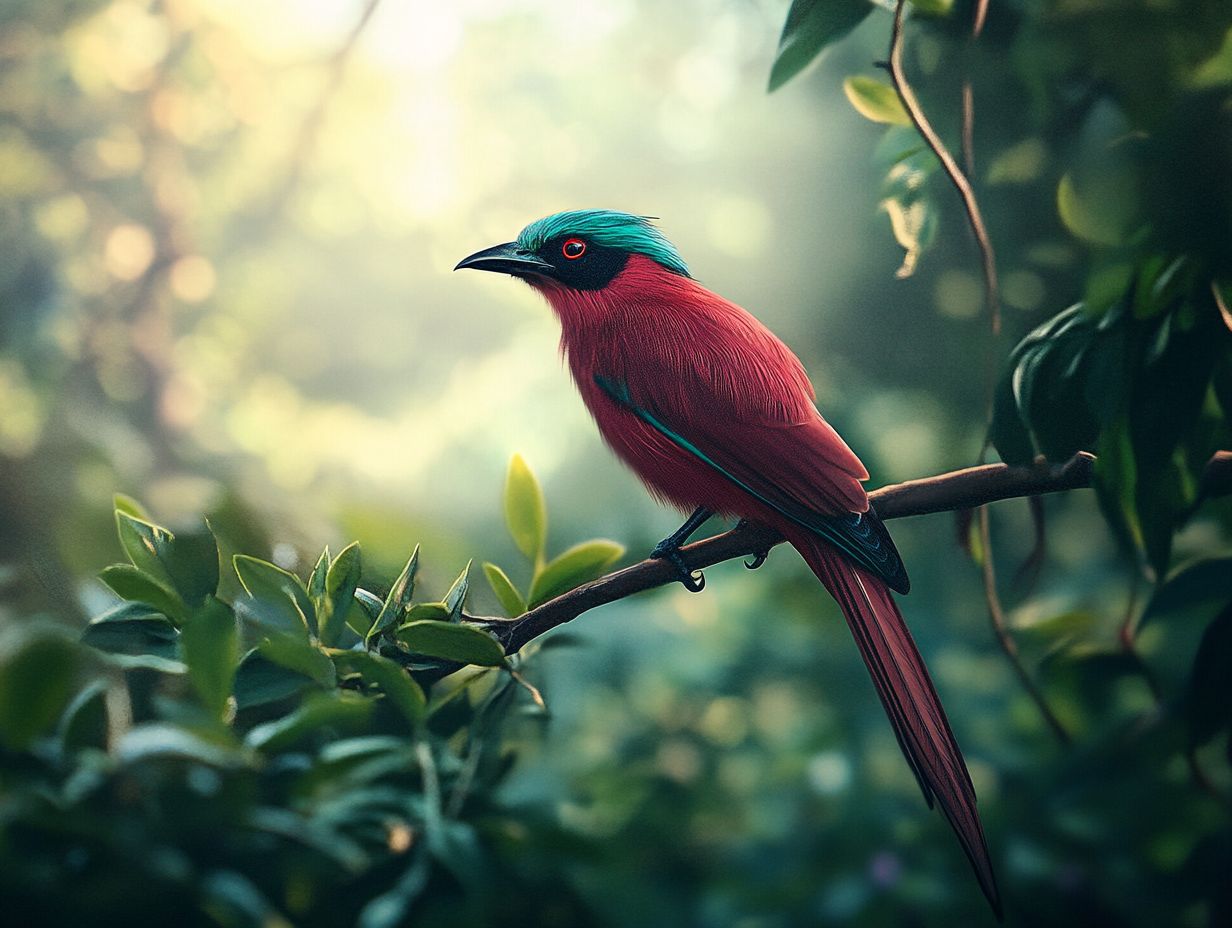
Cluttered backgrounds can significantly detract from the quality of your bird photographs, drawing attention away from the main subject. To create compelling images, consider negative space and subject placement, and learn how to use natural framing in bird photography when composing your shots.
A great strategy is to seek out clean, simple environments, such as a clear sky or a smooth surface like water, which can frame the bird beautifully. Using a wide aperture can blur distracting elements, isolating the subject and allowing it to shine. For optimal results, consider following the best practices for editing bird photos. Always keep an eye on the background; a slight shift in your angle can make all the difference.
Incorporating negative space allows the viewer s eyes to rest, emphasizing the bird’s details while maintaining a serene ambiance. This approach conveys not only the beauty of the subject but also the tranquility of its habitat. Grab your camera and start experimenting with these tips today!
Not Considering Lighting
Neglecting lighting conditions can harm your bird photographs. This affects both exposure and image clarity.
It s crucial to grasp various photography techniques and understand how different angles influence lighting. This knowledge helps you capture breathtaking avian portraits.
When you re out photographing birds, pay attention to the golden hours those enchanting moments just after sunrise and just before sunset. They cast a warm glow that enhances feather details and colors, making your images truly pop.
On overcast days, you ll find that diffused light works in your favor. It softens harsh shadows and allows for a more even exposure. Utilize techniques like reflectors or shoot in shaded areas to optimize the natural light available to you. Experiment with different camera settings and continuously adjust to changing conditions.
This approach elevates the quality of your bird photography, ensuring that every shot beautifully showcases the magnificence of these creatures.
Tips for Capturing Unique and Creative Shots
Capturing unique and creative shots of birds is a rewarding facet of photography that invites exploration and experimentation.
By integrating props and natural elements into your compositions and trying out various perspectives, you can craft distinctive images. These images showcase the beauty of your avian subjects and reveal their intriguing behaviors, much like those found in bird photography: capturing unique perspectives.
Dive into your photography journey! Discover new heights and unlock your creative potential!
Using Props and Natural Elements
Incorporating props and natural elements into your bird photography can significantly elevate both the composition and storytelling of your images. Understanding exposure for bird photography creates a more captivating visual experience.
By thoughtfully blending these elements, you can add depth and context to your work while showcasing your creative flair.
For example, a vibrant flower or a textured branch can draw the viewer’s eye to the bird. This beautifully highlights its natural habitat and behavior.
You might consider using a simple perch, like a twig or a stone, to craft a more dynamic scene that encourages movement and interaction.
Leveraging natural light, especially during the golden hour, can enhance the mood of your photographs. Select props that harmonize with the bird s colors or the surrounding environment for a cohesive composition.
This thoughtful approach enriches your visual narrative and effectively conveys the bird’s connection to its surroundings.
Experimenting with Different Perspectives
Experimenting with different perspectives is essential for capturing unique shots in bird photography. Varying your angles of view unveils new dimensions of your subject’s behavior and environment.
This approach elevates the visual impact of your images and inspires you to discover creative ways to portray avian life.
By shifting your position or altering your height, you can uncover striking contrasts and hidden narratives that might go unnoticed. For instance, shooting from a lower angle can highlight a bird s impressive wingspan against a vibrant sky. A top-down view may emphasize its intricate feather patterns.
Each perspective tells a distinct story, inviting viewers to immerse themselves in the scene.
These varied viewpoints reflect the dynamic nature of bird behavior. They showcase playful interactions among nestlings or the focused precision of a hunting raptor. Ultimately, this enriches your photographic experience and deepens the connection between your audience and the avian world.
Watch this video for tips on enhancing your bird photography!
Frequently Asked Questions
What are the best practices for bird photography composition?
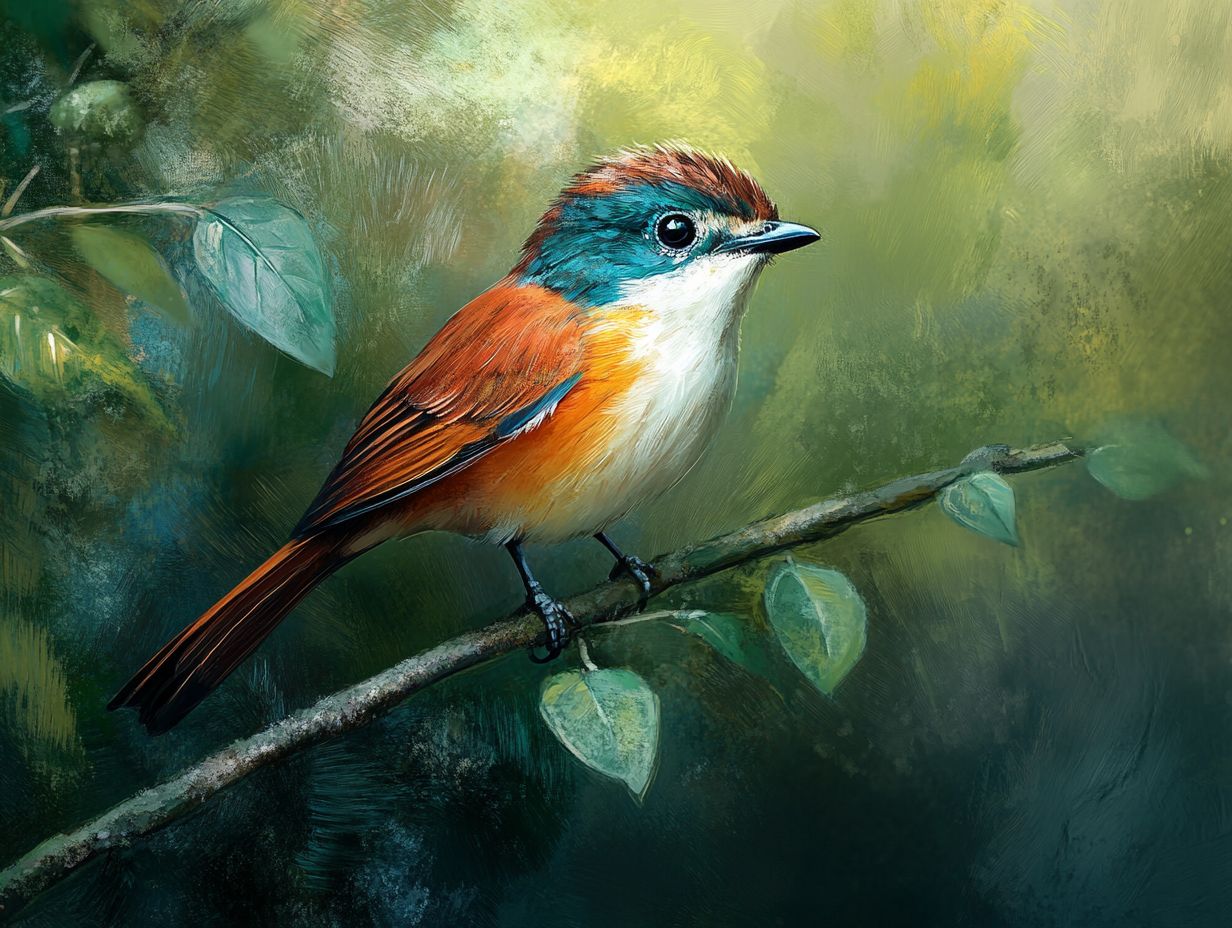
The best practices for bird photography composition include understanding the behavior of birds, using the rule of thirds, paying attention to lighting and background, and finding unique angles.
Why is understanding bird behavior important for composition?
Understanding bird behavior helps you predict their movements and anticipate shots. This allows you to capture more dynamic and interesting compositions.
How does the rule of thirds apply to bird photography composition?
The rule of thirds suggests placing your subject off-center. This creates a more visually appealing composition.
For bird photography, place the bird at one of the points where the imaginary grid lines cross.
Why is lighting important in bird photography composition?
Lighting significantly affects the quality of your photos. Soft, diffused light works best for capturing the rich details and colors of birds.
Avoid harsh lighting, as it can create unflattering shadows and highlights.
How can background affect bird photography composition?
The background can either enhance or distract from your main subject. A clean, uncluttered background makes your bird stand out!
What are some unique angles to consider for bird photography composition?
Consider unique angles like shooting from low or high perspectives. Capturing a bird in flight or using different lenses adds interesting dimensions to your shots!

